COMMON ALDER; GREY ALDER : Alnus glutinosa; Alnus incana
It is only on close examination that common and grey alders can be distinguished from one another: and it doesn't usually matter anyway. In fact the situation is made more complicated by the fact that the two species can hybridise - can cross-breed - producing trees with the characters of either one or somewhere between the two. Certainty is not available.

Alders are associated with wet conditions: they are to be found close to each of our watercourses on the Reserve: the first picture includes the path by the bridge. Bark texture varies considerably. First is the common alder, contrasting with the smoother (but older) grey alder. The third bark is intermediate and could well be from a hybrid of some sort.

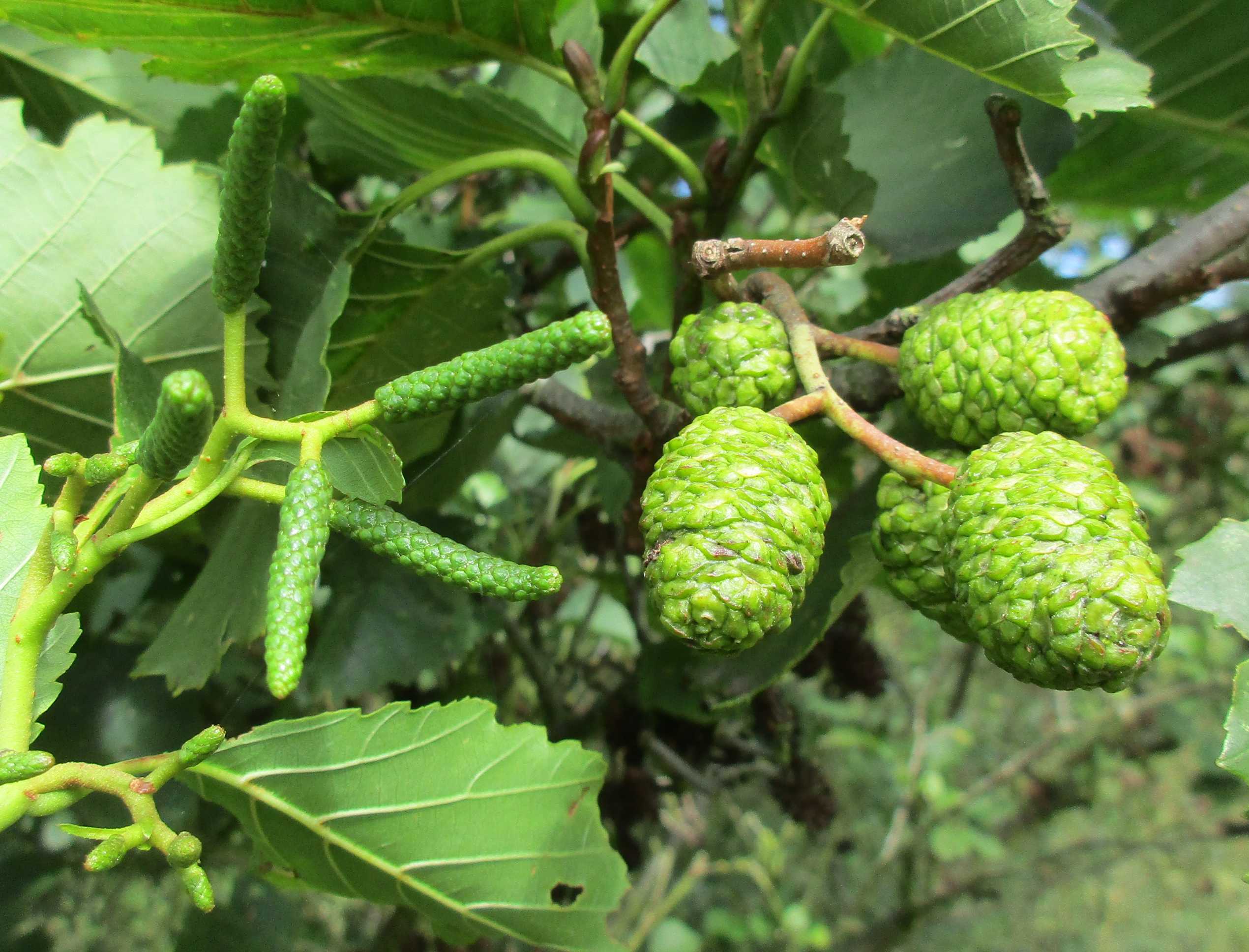
Here we have the tops and undersides of fairly representative leaves from, first, common alder (very rounded); second, grey alder (more pointed); third, a presumed hybrid. Then to complete the collection there is a rather extreme example of an infection which is to be seen on some leaves of most of our alders: detailed information is hard to come by.
Flowers are in the form of compact catkins, looking more like miniature cones in the case of the females: they will eventually house the seeds, and remain on the tree, brown, open and empty, into the following year. Males on the left. Photographed at the end of August.
ASH : Fraxinus excelsior

Several of the tallest trees on the Reserve are ash, albeit perhaps not the bulkiest as upper branches tend to be quite open. There is virtually always a workmanlike main trunk, fairly smooth when young. But, curiously, as they begin to mature some retain that smooth bark while in other cases the bark becomes quite coarsely ridged. It is possible, but difficult to confirm or exclude, that the smoother-barked individuals may be of
Fraxinus ornus, or perhaps a hybrid of some sort. Leaves are always large, made up of pairs of leaflets: top and underside views are shown. In the autumn those leaves will be shed while still quite green.

All ash trees have very characteristic black buds, in summer and easily spotted in winter. Less uniform, leaflets vary between individuals as regards their general outline and the edge toothing. The single-winged fruits are formed in bunches, to ripen and be shed from midsummer onwards.
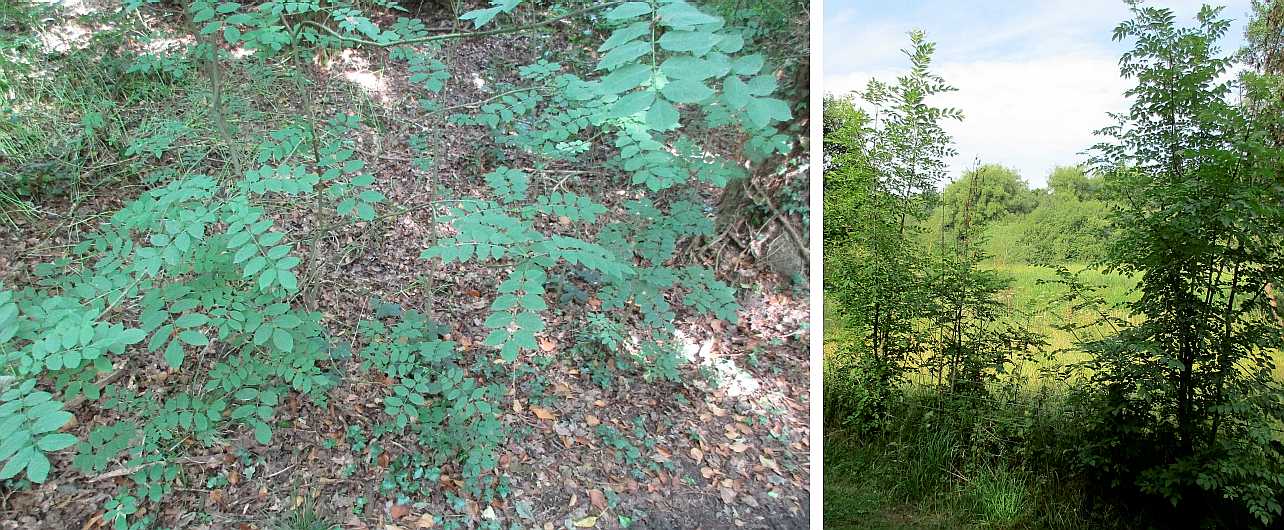
Those winged fruits with a seed in each are spectacularly effective: potential thickets of ash seedlings are to be found developing on deeply shaded forest floor areas; on the open un-mown edge of the conservation meadow; and elsewhere wherever tree felling has allowed light to reach new areas of woodland.
All those pictures were taken in the summer of 2017. The bad news concerns a fatal disease of ash trees which is known to exist in the area.
It is known as 'Ash dieback', or as 'Chalara dieback' as the guilty fungus was called
Chalara fraxinea though it has since been renamed
Hymenoscyphus fraxineus. Leaves on the twigs die back first, before the infection and damage spread to the whole crown of the tree usually with fatal results. There is no known treatment or control: the only hope is that natural selection will reveal some resistant ash strains. Otherwise it is feared that this latest invasion may prove to be as destructive as Dutch elm disease had been in the twentieth century.
In fact, just a few weeks after these notes were drafted the presence of the disease on the Reserve was officially confirmed by the Forestry Commission's Forest Research service.
BEECH : Fagus sylvatica

Beech trees in summer featured with their own mini-gallery on our home page. As a species, each beech tree nearly always divides into a number of 'trunks', often at strange angles that a theatre set designer would condemn as unrealistic. Their bark is usually fairly smooth, almosy shiny at times, but as the pictures show there is a lot of texture variation.

The summer leaves are modest in size, but are slightly stiff, held out at rght angles to absorb the maximum amount of light, casting the deepest possible shade in the process. Beech is unique in one respect - small trees retain their brown autumn leaves right through the winter. Curiously, it is a matter of what size they are, not how young they are: trimmed beech hedges do it no matter how old they are.
The rather unimpressive male and female flowers emerge in the spring at the same time as the leaves. |
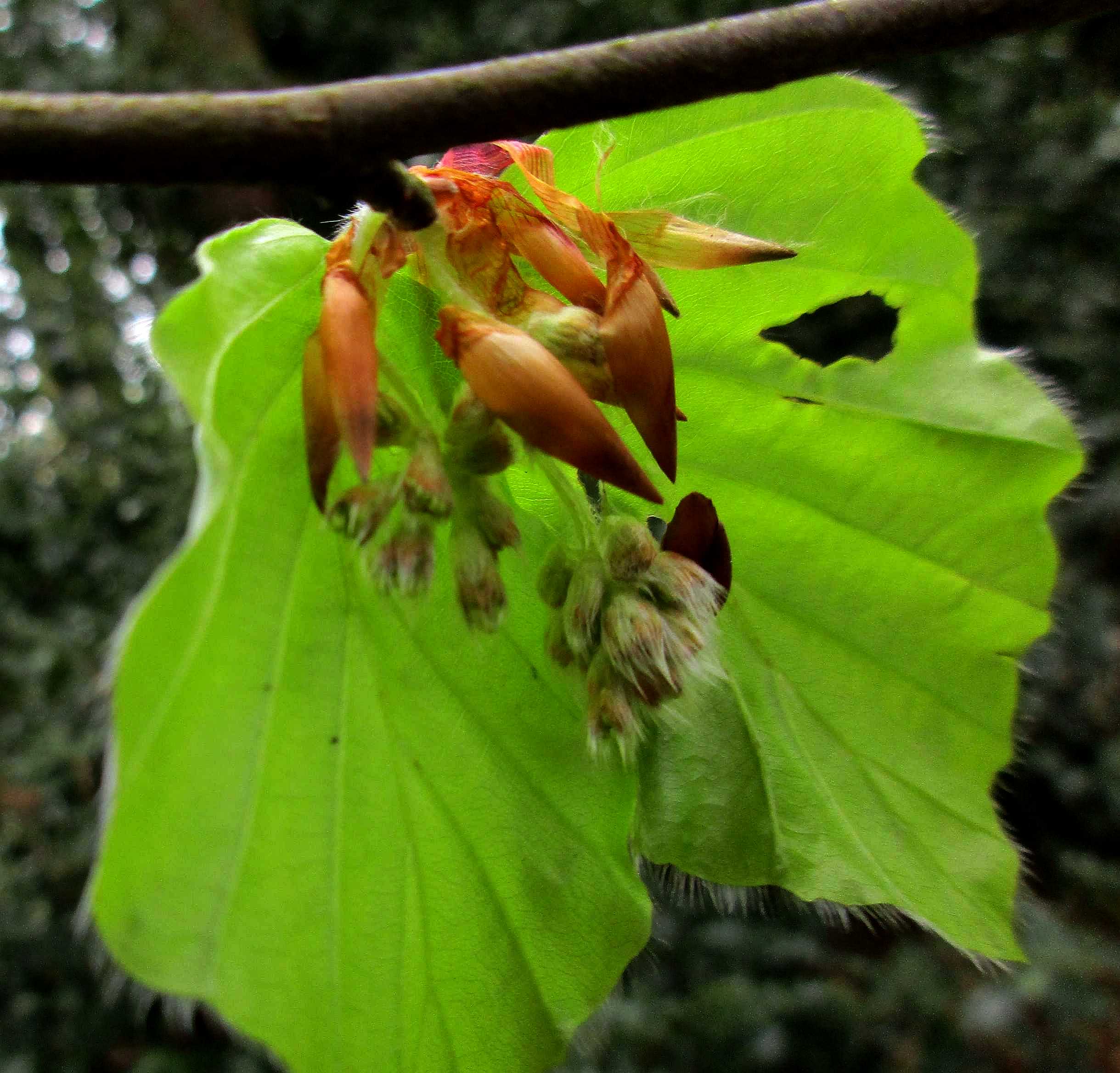 |
ENGLISH OAK : Quercus robur

Given the space, an oak tree tends to grow into a well rounded overall shape, but like all trees it will fight for light by growing tall in more crowded situations. The main trunk may be fairly uniform or it may include lumpy relics of earlier side branches. A single main stem may be regarded as normal, but many of our oaks were coppiced in an earlier century, resulting in two, three or more trunks developing from one previous stump. The bark is furrowed on a young tree, with the furrows deepening with increasing age.

An oak adjacent to one of the main paths is shown with summer growth. A typical oak leaf is featured, with top and underneath views. Springtime flowers are mini-catkins. Fresh young growth on new twigs is lighter in colour than the leaves on older branches. By midsummer acorns are beginning to be recognisable.
"Oak forests provide a habitat rich in biodiversity; they support more life forms than any other native trees. They host hundreds of species of insect, supplying many British birds with an important food source. In autumn mammals such as badgers and deer take advantage of the falling acorns. The soft leaves of English oaks break down with ease in autumn and form a rich leaf mould beneath the tree, supporting invertebrates, such as the stag beetle, and numerous fungi." That's according to the
Woodland Trust. Included in that biodiversity are so many organisms harmful to our oak trees that there's a special page showing them: click
here to see it - it will open in a new window (so that you can return here more easily).
HAWTHORN : Crataegus monogyna

The hawthorn is most often encountered in hedges and thickets, including some of those on our Reserve. But given the space it can grow into a considerable tree. The clearance of some undergrowth alongside the main path provided a rare opportunity to expose such a tree with access to its trunk: the painfully spiky branches and twigs normally make that impossible. The white spring flowers make a show, to be followed at the other end of the year by the red berries, the haws, beloved of many resident bird species. Traditionally, Boy Scouts maintain that every hawthorn has
some kindling amongst its twiggery!
HAZEL : Corylus avellana

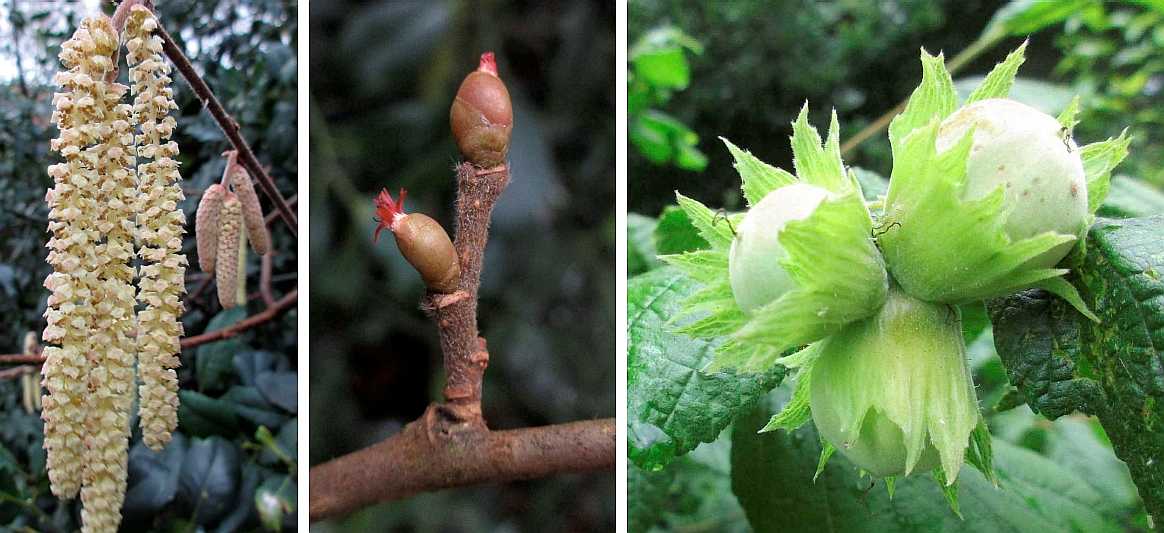
Hazel can grow as a normal-shaped tree but that rarely happens because it's too useful! It can be an ecologically useful contributor to any large hedge. There are a few UK commercial hazelnut plantations feeding their output principally onto the Christmas market. But the traditional and locally surviving husbandry system is as coppice - cutting the 'stools' down almost to ground level every few years. The resulting long, thin, flexible regrowth stems, easily split lengthways, were used in hurdle-making, wattle-and-daub building, thatching and many other applications, with any unsuitable material finding a use as kindling or for charcoal production. But if coppiced stools are abandoned the result is as shown in the second picture. The third picture shows the tree bark, left, and some useful younger shoots, right. All the summer pictures were taken in July: the nuts would be ripe a month or so later.
Hazel's January sex life is only half obvious. The flamboyant male catkins open up to spread their pollen on the winter winds. The hope is to reach the insignificant female 'flowers' which boast only some tiny feathery red stigmas to catch those microscopic pollen grains. The system evidently works - hence the summer nuts!
HOLLY : Ilex aquifolium

Truly evergreen hollies are widely distributed around the Reserve, but the majority are in shaded situations and are consequently quite small - just bushes really. But where conditions are suitable they have achieved forest tree status. (Bark is not needed for identification: it's usually impossible to reach any trunk anyway.) Prickly holly leaves are well known but are not universal: some individual leaves may be almost or completely prickle-free, and whole bushes can have flat leaves. Each plant is either male or female. Their small white flowers are shown, male above, female below. The resulting berries are on Christmas cards and female plants only.
HORNBEAM : Carpinus betulus

There is but a single specimen hornbeam on the Reserve, planted and protected inside its own fence adjacent to the footpath junction by the conservation meadow. But no such fence could protect against (grey) squirrels who have caused severe damage to the tree's trunk and branch bark which should be greyish and fairly smooth. Leaves are small but abundant. The springtime female catkins produce summer clusters of uniquely winged fruits which remain on the tree long after the leaves have been shed.
HORSE CHESTNUT : Aesculus hippocastanum

Endowed with the biggest leaves and the most showy flowers of any native tree, the largest seeds - conkers - give the horse chestnut international prestige by virtue of having their own
World Championship each October! The trees are strong growers, producing a dense mass of those bigger-than-A4 'palmate' leaves. The trunk bark is unremarkable, but the flowers can make a pleasing show, normally of white candlestick form: we have one large pink-flowered specimen close to the northern path.
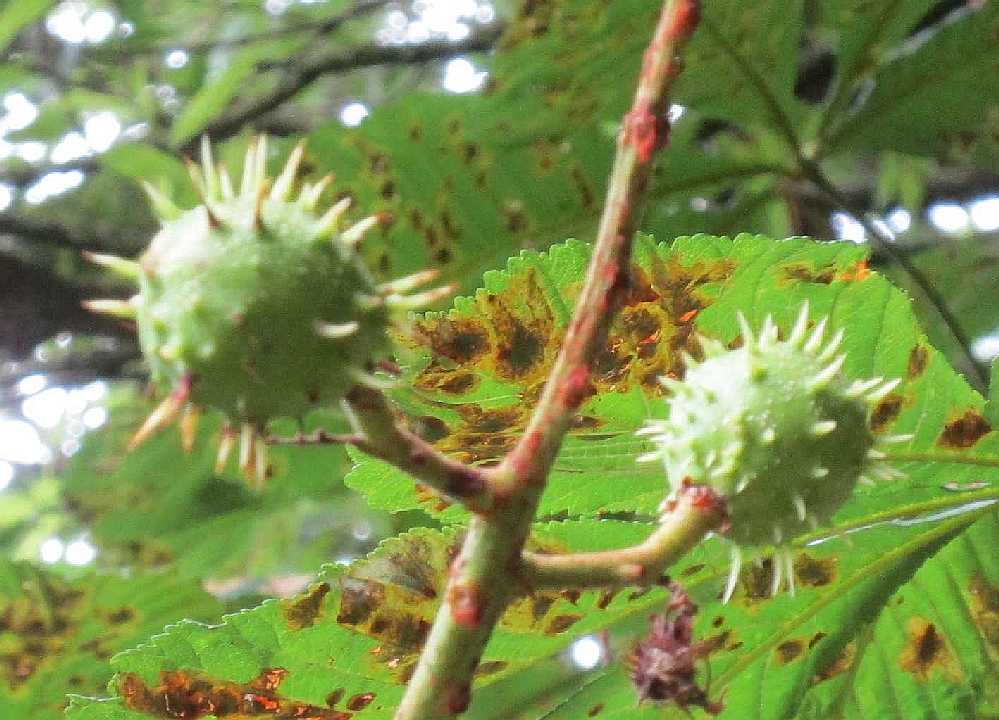

In the normal course of events the conkers will form in their very spiky cases from midsummer onwards.
But things can go wrong. Virtually all our horse chestnuts had diseased leaves turning to a fawn colour or dark brown in 2017. Like 'black-spot' on roses, horse chestnuts are subject to a red or brownish 'leaf blotch' disease caused by a fungus
Guignardia aesculi. But a couple (or more) of
Cameraria ohridella moths visited Wimbledon from Europe in 2002. They laid their eggs on a horse chestnut there and the resulting mini-caterpillars ate the softest parts of the inside of the leaves: such internal eating critters are called 'miners'. Thanks to their flying parents and offspring, horse chestnut leaf miners were found in every county of England and Wales by 2014. It is clear that our trees' damage is aligned with the side veins, confirming that miners are to blame. But having become damaged, the field is then wide open for the leaf blotch fungus to make a killing - literally. Fortunately, experience so far indicates that each tree starts the following year with a clean sheet: the combined attack kills the leaves but not the trees, though it must limit the trees' ability to grow properly. The severity of the attack is shown by the right-hand picture's browning of all the lower leaves.
MOUNTAIN ASH / ROWAN : Sorbus aucuparia


The leaves of ash trees and of mountain ash (rowan) trees are virtually identical: our Reserve includes seedling and young trees of both species. But whereas the ash can grow seemingly for ever the rowan is limited to a more modest 15 metres or so: we have only a few fully mature examples. The really characteristic thing about the mountain ash is that it has berries, pictured in July, which will turn bright orange/red later in the summer until they're eaten by the birds. Meanwhile, anyone needing to sort the rowans from the ashes need only look at the leaf arrangement on the twigs - alternate sides with rowan, in pairs (with those black buds) on ash.
NORWAY MAPLE : Acer platanoides

There are a few of these maples on the Reserve, some adjacent to paths. The leaves are of modest size, easily distinguished by their multi-spike outline: in common with other maples, those leaves top the poll when it comes to the autumn reds and yellows. Bark is authoritatively described as 'grey, smooth or finely ridged'. As featured elsewhere, Norway maples provide the earliest tree flowers each spring.
Like virtually every tree species, maples can suffer from sundry non-fatal diseases and infestations. |
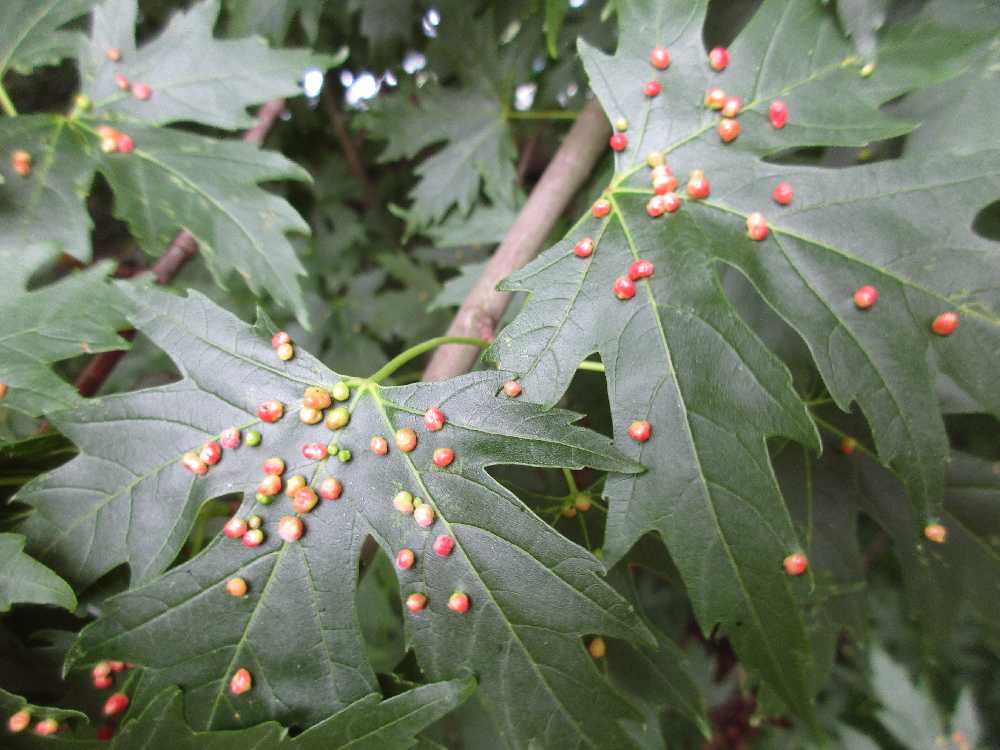 |
POPLAR : Populus nigra

There are some very young poplars on our Reserve, alongside the woodland path parallel to the railway line. There are only a few parental poplars nearby, but the youngsters are making good use of the sunlight available on that section of the path. Poplars make up a very confusing group: this one is sometimes known as the 'black poplar' but the rather light backs of the leaves could point towards 'grey poplar' or some hybrid. (They are certainly not the very distinctive closely related 'Lombardy poplars', familiar in other landscapes.)

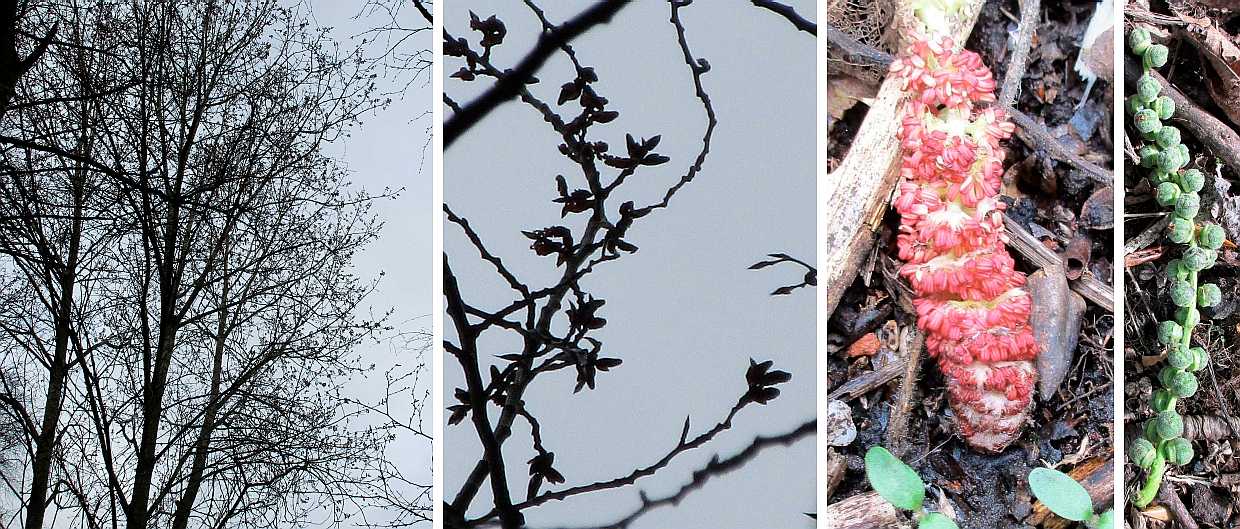
Elsewhere, between the two bridges, there is a small plantation of poplars, mature and so tall that leaf details can be seen only by telephoto or at autumn leaf-fall. Some leaves are very large, shown in the context of an A4 notebook and a six-inch ruler.
Again, our poplar catkins are much too high up to be seen when actively growing, in the early spring ahead of any leaf production. But storm damage brings a few of the decorative red male catkins down to ground level, and later on a few of the stringy blobby female catkins as seeds begin to develop inside them.
SCOTS PINE : Pinus sylvestris

There is no pine plantation on our Reserve but there are a good few individual Scots pines dotted around amongst the other trees. They are easy to describe, being evergreens with needle leaves carried high on not-very-wide branches supported on a single trunk with grooved, almost subdivided bark. But in common with other evergreens and deciduous trees, there are marked seasonal activities: the picture shows the burst of growth activity in the spring, extending the twigs and developing male and female cones. (Needle-drop and the shedding of redundant low branches are not seasonal.)

Those needles - they grow in pairs - photosynthesise in the same way that broad leaves do, though they don't have the bother of annual renewal, and they can cash in on whatever warmth and light may be available in the winter months. The small male cones shed their yellow pollen in the early summer, hoping to have fertilised the female cones so that seeds can develop inside those tightly closed wooden segments. Only after a two-year maturation will those scales open during warm weather to release the winged seeds - unless a squirrel got there first of course.
SILVER BIRCH : Betula pendula

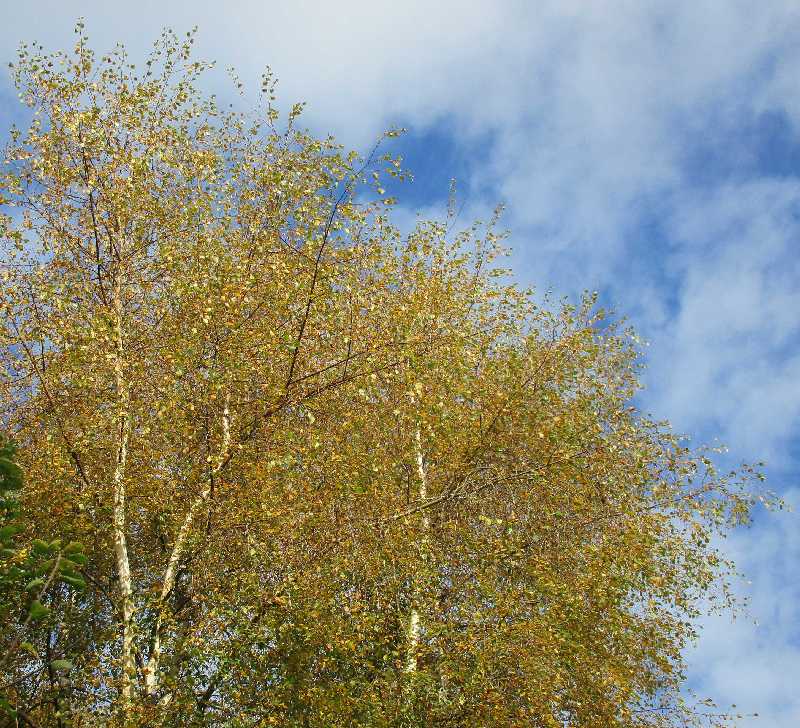
There are many silver birches in a variety of locations around the reserve. The familiar silvery-white trunk and major branches are topped off by light-textured leafage. The bark starts off fairly smooth with minor horizontal irregularities, but becomes increasingly gnarled over time. The leaves are modest in size, well-toothed on the leading edges. Summer catkins develop from July onwards. Autumn colours are not dramatic.
It is quite likely that some of our silver birches are in fact 'downy birch' trees,
Betula pubescens, especially on the wetter areas. Or there may be hybrids between the two species!
SWEET CHESTNUT : Castanea sativa

There seems to be only a single, very un-typical specimen of sweet chestnut within the areas of the Nature Reserve accessible to the public: it's not far from the railway line, part way along the woodland path. The twisted main stem hardly justifies the term 'trunk': perhaps tree surgery could help? As an immature tree it seems not to bear any flowers or nuts. But it does produce a goodly crop of large leaves resulting in a dense canopy overhead.
SYCAMORE : Acer pseudoplanatus

Sycamores enjoy mixed reputations, as magnificent specimen trees and as weed seedlings in unwanted profusion. It's a sort of English (originally European) maple, with the Canadian Emblem leaves common to all the family. The bark starts off quite smooth but soon cracks and finally becomes flaking and rough. Well recognised from midsummer onwards, seed production is prolific in the form of paired wings, known as
samaras: unlike other maples, the pair are just about at right-angles to one another.
WILD CHERRY : Prunus avium

Of the various cherry species to be found in the Reserve, this is the only one to produce any significant - and marginally edible - summer fruit.
WILLOW : Salix species

Various willows make huge and crucial contributions to all the Mill Green damper ecosystems: they like to have their roots kept moist. Apart from a few alders and a small wild cherry in the foreground and in the distance every tree in the first picture is a willow. The second picture emphasises the impressive height achieved by some of these contributors - assuming that you spotted the two runners on the path, to give a sense of scale. Characterful trunks enhance every main-path circuit. But they're not quite
weeping willows are they? So what kinds
are they?

Well, only a few kinds of willow are capable of growing to the size we have on our Reserve, principally the 'crack willow',
Salix fragilis, and the 'white willow',
Salix alba. It's quite clear from the pictures of their bark that we have indeed got two types. And the last picture shows exactly why one of them is called 'crack' and what's
fragile about it. It is simply that there are circumstances in which the limbs of 'crack willow' can grow to become too heavy to be supported by the structure lower down: so the stressed branch cracks. The breakage shown here occurred on June 23rd, 2017. This picture was taken on the 9th of July: buds on the still-attached section have already begun to produce fresh shoots, just sixteen days after the break. The rough-bark willow is evidently
Salix fragilis.

Do the leaves give any clue as to the identity of the smooth-bark willow? If it is 'white willow' the backs of the leaves should be white, but that is not noticeably the case with ours, shown in the photos. It is true that such features are quite variable. And it is also the case that willow is known to produce hybrids, making it impossible to be specific. Other features are unlikely to make things easier. There are some mid-season new twigs with small leaves. The right-hand picture is of uncontrolled proliferation, probably caused by a gall mite upsetting the hormone chemistry of the system.

Our willows produce their catkins in early May, releasing pollen onto the winds. The very narrow yellowing leaves may be of a different willow, caught at a time of high-temperature stress perhaps. The final picture is of what seems to be a bushy willow out there on an inaccessible lake edge or island: it could be 'pussy willow',
Salix caprea.
YEW : Taxus baccata
 |
There do not seem to be any mature yew trees on our Reserve. But there are a number of young seedlings, probably arising from seeds brought in by birds from the surrounding area. Yews are evergreens, able to thrive in partial shade. Ours are too immature to have any typical bark: nor have they yet produced the small red 'aril' fruits unique to the yew. |










 Here we have the tops and undersides of fairly representative leaves from, first, common alder (very rounded); second, grey alder (more pointed); third, a presumed hybrid. Then to complete the collection there is a rather extreme example of an infection which is to be seen on some leaves of most of our alders: detailed information is hard to come by.
Here we have the tops and undersides of fairly representative leaves from, first, common alder (very rounded); second, grey alder (more pointed); third, a presumed hybrid. Then to complete the collection there is a rather extreme example of an infection which is to be seen on some leaves of most of our alders: detailed information is hard to come by.

 Those winged fruits with a seed in each are spectacularly effective: potential thickets of ash seedlings are to be found developing on deeply shaded forest floor areas; on the open un-mown edge of the conservation meadow; and elsewhere wherever tree felling has allowed light to reach new areas of woodland.
Those winged fruits with a seed in each are spectacularly effective: potential thickets of ash seedlings are to be found developing on deeply shaded forest floor areas; on the open un-mown edge of the conservation meadow; and elsewhere wherever tree felling has allowed light to reach new areas of woodland.






 Hazel can grow as a normal-shaped tree but that rarely happens because it's too useful! It can be an ecologically useful contributor to any large hedge. There are a few UK commercial hazelnut plantations feeding their output principally onto the Christmas market. But the traditional and locally surviving husbandry system is as coppice - cutting the 'stools' down almost to ground level every few years. The resulting long, thin, flexible regrowth stems, easily split lengthways, were used in hurdle-making, wattle-and-daub building, thatching and many other applications, with any unsuitable material finding a use as kindling or for charcoal production. But if coppiced stools are abandoned the result is as shown in the second picture. The third picture shows the tree bark, left, and some useful younger shoots, right. All the summer pictures were taken in July: the nuts would be ripe a month or so later.
Hazel can grow as a normal-shaped tree but that rarely happens because it's too useful! It can be an ecologically useful contributor to any large hedge. There are a few UK commercial hazelnut plantations feeding their output principally onto the Christmas market. But the traditional and locally surviving husbandry system is as coppice - cutting the 'stools' down almost to ground level every few years. The resulting long, thin, flexible regrowth stems, easily split lengthways, were used in hurdle-making, wattle-and-daub building, thatching and many other applications, with any unsuitable material finding a use as kindling or for charcoal production. But if coppiced stools are abandoned the result is as shown in the second picture. The third picture shows the tree bark, left, and some useful younger shoots, right. All the summer pictures were taken in July: the nuts would be ripe a month or so later.



 In the normal course of events the conkers will form in their very spiky cases from midsummer onwards.
In the normal course of events the conkers will form in their very spiky cases from midsummer onwards.
 The leaves of ash trees and of mountain ash (rowan) trees are virtually identical: our Reserve includes seedling and young trees of both species. But whereas the ash can grow seemingly for ever the rowan is limited to a more modest 15 metres or so: we have only a few fully mature examples. The really characteristic thing about the mountain ash is that it has berries, pictured in July, which will turn bright orange/red later in the summer until they're eaten by the birds. Meanwhile, anyone needing to sort the rowans from the ashes need only look at the leaf arrangement on the twigs - alternate sides with rowan, in pairs (with those black buds) on ash.
The leaves of ash trees and of mountain ash (rowan) trees are virtually identical: our Reserve includes seedling and young trees of both species. But whereas the ash can grow seemingly for ever the rowan is limited to a more modest 15 metres or so: we have only a few fully mature examples. The really characteristic thing about the mountain ash is that it has berries, pictured in July, which will turn bright orange/red later in the summer until they're eaten by the birds. Meanwhile, anyone needing to sort the rowans from the ashes need only look at the leaf arrangement on the twigs - alternate sides with rowan, in pairs (with those black buds) on ash.




 Elsewhere, between the two bridges, there is a small plantation of poplars, mature and so tall that leaf details can be seen only by telephoto or at autumn leaf-fall. Some leaves are very large, shown in the context of an A4 notebook and a six-inch ruler.
Elsewhere, between the two bridges, there is a small plantation of poplars, mature and so tall that leaf details can be seen only by telephoto or at autumn leaf-fall. Some leaves are very large, shown in the context of an A4 notebook and a six-inch ruler.


 There are many silver birches in a variety of locations around the reserve. The familiar silvery-white trunk and major branches are topped off by light-textured leafage. The bark starts off fairly smooth with minor horizontal irregularities, but becomes increasingly gnarled over time. The leaves are modest in size, well-toothed on the leading edges. Summer catkins develop from July onwards. Autumn colours are not dramatic.
There are many silver birches in a variety of locations around the reserve. The familiar silvery-white trunk and major branches are topped off by light-textured leafage. The bark starts off fairly smooth with minor horizontal irregularities, but becomes increasingly gnarled over time. The leaves are modest in size, well-toothed on the leading edges. Summer catkins develop from July onwards. Autumn colours are not dramatic.






